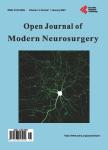Surgical Repair of Encephaloceles in Gabriel TouréHospital: Review of 17 Cases
Surgical Repair of Encephaloceles in Gabriel TouréHospital: Review of 17 Cases作者机构:Department of Neurosurgery Hô pital Gabriel Touré Bamako Mali Department of Neurosurgery Hô pital du Mali Bamako Mali Department of Pediatric Surgery Hô pital Gabriel Touré Bamako Mali Department of Neurology Hô pital Gabriel Touré Bamako Mali Department of Anesthesiology and ICU Hô pital Gabriel Touré Bamako Mali Department of Pediatrics Hô pital Gabriel Touré Bamako Mali
出 版 物:《Open Journal of Modern Neurosurgery》 (现代神经外科学进展(英文))
年 卷 期:2018年第8卷第4期
页 面:375-382页
学科分类:1002[医学-临床医学] 100214[医学-肿瘤学] 10[医学]
主 题:Encephalocele Neural Tube Defect Hydrocephalus Congenital Malformation
摘 要:Background: Encephaloceles are congenital neural tube defects characterized by the protrusion of meninges and/or brain tissue from a defect in the skull. The incidence of the disease is about 0.8 - 5.6/10,000 live births. They are classified based on the location and type of skull defect as occipital encephalocele, encephalocele of the cranial vault, frontoethmoidal encephalocele, and basal encephaloceles. Surgical reduction being the first line treatment and resection of herniated structures may be necessary when the encephalocele is large. In the present study, the authors present their experience in treating 17 patients with encephaloceles. Methods: This study is a retrospective analysis of 17 patients from January 2013 to December 2016 in Gabriel Touré Hospital, Bamako, Mali. A history was obtained from the family at presentation. Medical information before and during the pregnancy was compiled. All patients underwent CT scan as a routine preoperative imaging study, to evaluate the encephalocele and to plan the surgical procedure. The following data were recorded for analysis: age, sex, location of encephalocele, neurological status, operative method, postoperative complications and surgical results. Results: There were 10 (58.8%) female and 7 (41.2%) male patients. The patients ranged in age from 3 days to 36 months. The most common site of encephalocele sac was the occipital region in 14 (82.4%) cases followed by the frontal region in 2 (11.8%) cases and the vertex in 1 (5.9%) case. The sac size was less than 3 cm in 5 (17.6%) cases, 3 - 5 cm in 8 (47.1%) cases and more than 5 cm in 4 (23.5%) cases. Three (17.6%) children presented with CSF leakage. Hydrocephalus was present in the preoperative period in 6 (35.3%) cases;all of them required VP shunt procedure. None of the cases had a preoperative neurologic deficit. Surgical excision was performed in all cases. In the postoperative period, meningitis developed in 2 cases (11.8%), wound infection in 1 case (5.9%) and seizure in 1 case (5.9%). Three patients (17.6%) died during postoperative follow-up. Postoperative hydrocephalus occurred in 1 (5.88%) patient requiring a VP shunt. Conclusion: Encephaloceles are commonly seen in the practice of neurosurgery in the world as well as in Mali. In this study, the clinical manifestations and surgical results of 17 cases have been reviewed. We recommend early repair and excision of encephaloceles to avoid rupture or skin excoriation.



